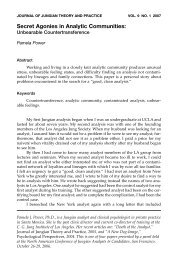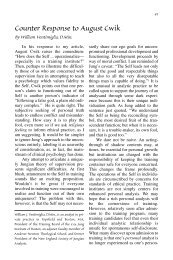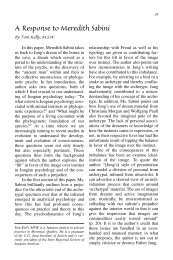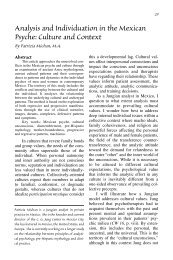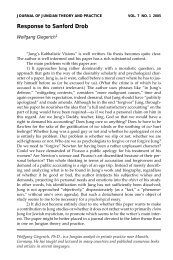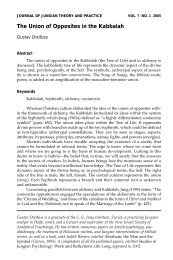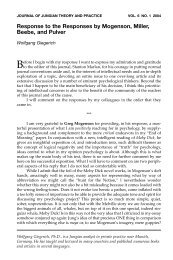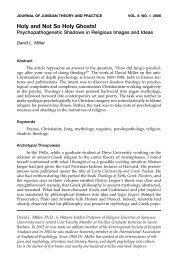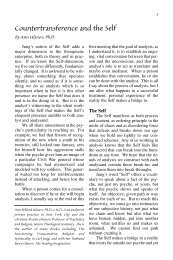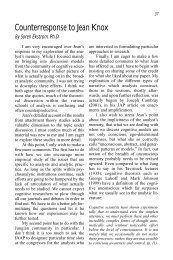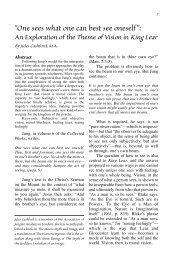JOURNAL OF JUNGIAN THEORY AND PRACTICE - CG Jung ...
JOURNAL OF JUNGIAN THEORY AND PRACTICE - CG Jung ...
JOURNAL OF JUNGIAN THEORY AND PRACTICE - CG Jung ...
You also want an ePaper? Increase the reach of your titles
YUMPU automatically turns print PDFs into web optimized ePapers that Google loves.
<strong>JOURNAL</strong> <strong>OF</strong> <strong>JUNGIAN</strong> <strong>THEORY</strong> <strong>AND</strong> <strong>PRACTICE</strong>Vol. 7 No. 2 2005C. G. <strong>Jung</strong>’s Answer To Job: A Half Century LaterJ. Marvin SpiegelmanAbstractA detailed summary of <strong>Jung</strong>'s Answer to Job is presented, along witha commentary on it and on how <strong>Jung</strong>'s insights have held up over a halfcentury, particularly in the area of the rise of the feminine principle. Furthersections discuss the role of eros, further Biblical material, and intuitions onhow the various strands in the world image of the Self (particularly amongthe monotheisms) are developing.KeywordsJob, the Feminine, evil, eros, Biblical progression, Judaeo-Christianpsychology, strands in the Self.The invasion of evil signifies that something previously good hasturned into something harmful . . . the ruling moral principle, althoughexcellent to begin with, in time loses its essential connection with life,since it no longer embraces life’s variety and abundance. What isrationally correct is too narrow a concept to grasp life in its totalityand give it permanent expression.C. G. <strong>Jung</strong>’s Answer To Job: A Half Century Later Pg. 46 (Online Edition)by J. Marvin Spiegelman
(C. G. <strong>Jung</strong>, Answer to Job)IIt is now more than half a century since C. G. <strong>Jung</strong> wrote Answer toJob (<strong>Jung</strong>, 1952), to my mind one of the most important spiritual texts of thetwentieth century. That book was nothing less than a psychological study ofthe history of God over the last twenty-five hundred years. Lessspectacularly considered, <strong>Jung</strong> attempted to understand how the Self, theimage of God in the Western psyche, had undergone change anddevelopment over that time. Of special interest to him was the problematiccondition of that psychological image at the approaching end of theChristian aion, as <strong>Jung</strong> put it.As might be expected, the book was greeted with alarm andmisunderstanding, both in theological and scientific circles, but has enjoyeda continuing interest among the educated public. The larger academic worldhas neglected this book, but a recent scholarly work has gathered together allthe relevant literature (Bishop, 2002). Theologians, such as Victor White,from the Catholic side (White, 1959), and Martin Buber, from a Jewishperspective (Buber, 1952), found much to criticize in <strong>Jung</strong>’s attempt at the“psychization,” so to speak, of the God image. Comments even from someof <strong>Jung</strong>’s followers suggest a lack of understanding of what he was about. Ina 1993 volume of the Journal of Analytical Psychology, for example, twoanalysts, one from Britain and one from Israel, believed it necessary tointerpret the text reductively, as reflecting <strong>Jung</strong>’s childhood problems, so itis not surprising that this major work has proved difficult for many to grasp.On the other hand, another <strong>Jung</strong>ian, Edward Edinger, has written anC. G. <strong>Jung</strong>’s Answer To Job: A Half Century Later Pg. 47 (Online Edition)by J. Marvin Spiegelman
excellent introduction and commentary (Edinger, 1992). A former Jesuit,Jack Miles, has done something similar to <strong>Jung</strong> in writing a Biography ofGod (Miles, 1995), also basing himself on the Biblical text. In a personalcommunication, he told me that Answer to Job had impressed him, but that<strong>Jung</strong> did not sufficiently appreciate the role of Israel. I shall quote some ofhis work later on and add to it as well.In this paper I propose to examine how <strong>Jung</strong>’s predictions have heldup and suggest how what he was trying to do can be extended, even if only alittle. I will begin by presenting a summary of that book, together with somecomments, to refresh those who may not have read it for some time and toprovide necessary information for those who have not studied it. I begin bygiving the flavor of <strong>Jung</strong>’s (1952) writing, after the introduction:The book of Job is a landmark in the long historical development of adivine drama. At the time the book was written, there were alreadymany testimonies which had given a contradictory picture ofYahweh—the picture of a God who knew no moderation in hisemotions and suffered precisely from this lack of moderation. Hehimself admitted that he was eaten up with rage and jealousy and thatthis knowledge was painful to him. Insight existed along with cruelty,creative power along with destructiveness. Everything was there, andnone of these qualities was an obstacle to the other. Such a conditionis only conceivable either when no reflecting consciousness is presentat all, or when the capacity for reflection is very feeble and a more orless adventitious phenomenon. A condition of this sort can only bedescribed as amoral. (para. 560)C. G. <strong>Jung</strong>’s Answer To Job: A Half Century Later Pg. 48 (Online Edition)by J. Marvin Spiegelman
So does <strong>Jung</strong> begin. He describes himself as a “modern man with aChristian education and background,” but his astonishing insight also gives aJew like me pause. One must note that the general Judaeo-Christianunderstanding is that it was this same God image that demanded the highestlevel of moral attainment that was possible in the ancient world. We arefaced with the power of this divine antinomy and the experience of it in Job,whose greatest quality, says <strong>Jung</strong>, is that “he does not doubt the unity ofGod.” He clearly sees that God is at odds with himself—so flatly at odds thatJob is quite certain of finding in God a helper, an “advocate” against God.As certain as he is of the evil in Yahweh, he is equally certain of the good(para. 567). God is a personality and tremendously involved withhumankind, in contrast with the all-ruling Father Zeus, who “in a benevolentand somewhat detached manner” (para. 568) allows the universe to go along,and only punishes the disorderly. The Greek god did not moralize but ruledinstinctively, demanding only the sacrifices due him, had neither plans fornor much involvement with human beings. The Jewish god needed humanbeings and swore to David, for example in the 89 th Psalm, that he would notlie to him. Yet he “who watched so jealously over the fulfillment of laws andcontracts, broke his own oath” (para. 570). This is an image of a being thatlacks self-reflection. He is not imperfect or evil, like a Gnostic demiurge, butis everything in its totality.Why, then, does God need man? He needs humankind, says <strong>Jung</strong>, inorder to achieve a greater consciousness, a more precise rendering of himselfto himself. Yet he is ambivalent about this, abandoning his faithful servantJob to evil. This poor victim of a divine plot is thereby secretly lifted up to asuperior knowledge which God himself does not possess, namely his ownantinomy. Yet we discover that Job is an outward occasion for an inwardC. G. <strong>Jung</strong>’s Answer To Job: A Half Century Later Pg. 49 (Online Edition)by J. Marvin Spiegelman
dialectic in God himself (para. 587). It is as if God projects his skepticism onJob and the latter is challenged as though he, himself, were a god!Man is enormously elevated thereby, something that has neverhappened before: “Without knowing or wanting it, a mortal man is raised byhis moral behavior above the stars in heaven, from which position ofadvantage he can behold the back of Yahweh, the abysmal world of‘shards’” (para. 595). <strong>Jung</strong> is referring here to the idea in Kabbalah that theshards are counterpoles to the ten sephiroth or stages in the revelation andmanifestation of God’s creative power. The shards represent the forces ofevil, which are a by-product of the process of the sephiroth manifesting anda consequence of previous, inadequate experiments in creation. Job hasdiscovered that God is a phenomenon, “not a man”—even less than humanat times (para. 600). <strong>Jung</strong> points out that to assume that the creator of theworld is a conscious being is a disastrous prejudice which leads to suchnonsensical doctrines as the privatio boni, that evil is just the absence ofgood. Job reacts in an adjusted way, but sees that Yahweh behaves asirrationally as a cataclysm and then “wants to be loved, honored, worshippedand praised as just. . . . One can submit to such a God only with fear andtrembling . . . but a relationship of trust is out of the question to our modernway of thinking” (paras. 604-605). Yet Yahweh demands loyalty and gets it.By humiliating Job, however, he pronounces judgment on himself and givesman moral satisfaction that is not recognized. This could have resulted in therelativization that affected the Greek gods, but this did not happen for thenext two thousand years. Yet God’s dual nature was perceived by theunconscious mind of man and this was bound to have far-reachingconsequences.C. G. <strong>Jung</strong>’s Answer To Job: A Half Century Later Pg. 50 (Online Edition)by J. Marvin Spiegelman
<strong>Jung</strong> now makes a discursus back to the time when the Book of Jobwas written, between 600 and 300 B.C.E., which places it also about thetime of the Book of Proverbs. He does so in order to assess what washappening in the psyche at this time. He thereby demonstrates thedevelopment of the idea of the “incarnation” and the subsequent emergenceof the Christian story. The Book of Proverbs shows the effect of Greekinfluence in that the idea of Sophia, the Sapentia Dei or Wisdom of God, ispresented as a feminine spirit that existed before Creation. This Sophia is apart of God with characteristics like the Johannine Logos, the Chochma ofKabbalah, and also Indian Shakti. This feminine wisdom is exalted as theWord of God, who brooded over the waters at the beginning and has herthrone in heaven. In the Wisdom of Solomon, she is wisdom as a loving spiritand “better than might.” Again I quote more fully from <strong>Jung</strong>:From the ancient records we know that the divine drama was enactedbetween God and his people, who were betrothed to him, themasculine dynamis, like a woman, and over whose faithfulness hewatched jealously. A particular instance of this is Job, whosefaithfulness is subjected to a savage test. As I have said, the reallyastonishing thing is how easily Yahweh gives in to the insinuations ofSatan. If it were true that he trusted Job perfectly, it would be logicalfor Yahweh to defend him, unmask the malicious slanderer, and makehim pay for his defamation of God’s faithful servant. But Yahwehnever thinks of it, not even after Job’s innocence has been proved. Wehear nothing of a rebuke or disapproval of Satan. Therefore we cannotdoubt Yahweh’s connivance. His readiness to deliver Job into Satan’smurderous hands proves that he doubts Job precisely because heC. G. <strong>Jung</strong>’s Answer To Job: A Half Century Later Pg. 51 (Online Edition)by J. Marvin Spiegelman
projects his own tendency to unfaithfulness upon a scapegoat. There isreason to suspect that he is about to loosen his matrimonial ties withIsrael but hides this intention from himself. (para. 616)<strong>Jung</strong> shows that God, with the help of Satan, infallibly picks on themost faithful of the lot, Job. At the same time, God remembers a femininebeing who was a friend and playmate from the beginning of the world, afirstborn “stainless reflection of his glory and a master workman,” namely,Sophia (para. 617). There must be some dire necessity for this anamnesis ofSophia; things just could not go on as before. The “just” God could not goon committing injustices and the ”Omniscient” could not behave any longerlike a clueless and thoughtless human being. Self-reflection becomesimperative, and for this Wisdom is needed. We realize that the failure tocorrupt Job has induced changes in Yahweh’s nature.<strong>Jung</strong> carefully traces the early archetypal stories involving the pureson and impure one. He also reminds us that God did not say “it is good” forthe creation of Monday, the second day, in which separation of the upperand lower firmament took place. This dualism was not “good.” In thepleroma, the background, there is a perfect interplay of cosmic forces, butwith Creation—the division of the word into distinct processes in space andtime—conflict occurs. Perfection and completion begin their opposition. Wealso now discover that Yahweh’s marriage with Israel had perfectionist aimsin it and lacked the kind of relatedness that we now know as “eros.” Ratherthan values and the appreciated subjectivity of the partner, there is only arelationship to a purpose which man must help to fulfill. Faithfulness of hispeople becomes more important the more he forgets Wisdom.C. G. <strong>Jung</strong>’s Answer To Job: A Half Century Later Pg. 52 (Online Edition)by J. Marvin Spiegelman
Job is the climax of this development. Man sees the split in God,needs Wisdom as an advocate. God, having been met and seen, needs hertoo. Therefore, this realization of Sophia, Wisdom, betokens a coming act ofcreation, which uses the Egyptian model of incarnation, in Pharaoh, but thisis not merely repeating the archetype mechanically. “The real reason forGod’s becoming man is to be sought in his encounter with Job” (para. 634).This time it is not the world that is to be changed. Rather, it is God whointends to change his own nature. Only one human being is to be created, aGod-man, born of a human woman, a second Eve. This incarnation was onlypartial, since it was necessary to protect against evil, and thus he was moredivine than human. Therefore, the perfectionism continued. Yet, says <strong>Jung</strong>:“One should make clear to oneself what it means when God becomes man. Itmeans nothing less than a world-shaking transformation of God. It meansmore or less what Creation meant in the beginning, namely an objectivationof God. At the time of the Creation, he revealed himself in nature; now hewants to be more specific and become man” (para. 631).From this we can understand that God is reality itself. When Godcreated the world from the “void,” he breathed his own mystery into everypart of it. From this comes the belief that it is possible to know God from hiscreation (para. 630). If God is in everything already, why the incarnation?One would like to say that Christ had to appear in order to deliver mankindfrom evil, but, in fact, Yahweh could have simply stopped Satan, if he hadwished. Rather, what we see is that “Yahweh [God] must become manprecisely because he has done man a wrong. He, the guardian of justice,knows that every wrong must be expiated, and Wisdom knows that morallaw is above even him. Because his creature has surpassed him he mustregenerate himself” (para. 640, italics added). <strong>Jung</strong> does not bring to ourC. G. <strong>Jung</strong>’s Answer To Job: A Half Century Later Pg. 53 (Online Edition)by J. Marvin Spiegelman
attention here the familiar medieval image of Mary cradling the unicorn inher lap, seen as the wrath of God contained by her in conceiving the newdivine child, but the link with this particular symbol of regeneration is mostapropos.<strong>Jung</strong> now shows us how the hero myth is invoked in order to bringabout the desired experience of the divine, who now needs to know what it islike to be a human being. The dove and the love-goddess are implied, but thechange in the ordinary myth of the hero-god dying young is shown by theprecise experience of Christ. He is certainly identified with his love ofhumankind, but the scriptures also reveal a “certain irascibility” in histemperament, as is often the case with people who do not reflect aboutthemselves. The great exception to this lack of questioning himself is foundonly at the very end, when he cries despairingly on the cross, “My God, myGod, why hast thou forsaken me?” <strong>Jung</strong> now reveals what this means: “Herehis human nature attains divinity; at that moment God experiences what itmeans to be a mortal man and drinks to the dregs what he made his faithfulservant suffer. Here is given the answer to Job and, clearly, this suprememoment is as divine as it is human, as ‘eschatological’ as it is‘psychological’” (para. 647).<strong>Jung</strong> tells us that Yahweh has now become the “good” God, but askswhat we are to make of the cautious petition inserted into the prayer, “Leadus not into temptation?” That carry-over from the Psalms is hardly the markof a divine who is the summum bonum. At this point, however, <strong>Jung</strong>contrasts the Catholic and Protestant views, which essentially results infreedom being seen as greater in the latter, but there is more rigidity, too, inthat only the Scriptures are regarded as the word of God. Catholicism, withthe doctrine of the Holy Spirit, can allow further revelations, such as theC. G. <strong>Jung</strong>’s Answer To Job: A Half Century Later Pg. 54 (Online Edition)by J. Marvin Spiegelman
important one of the Assumptio Mariae. Jesus, we are made to see, is notfully human, and it is clear that “just as man suffers from God, so God mustsuffer from man” (para. 657, italics added). It is in this way, one might add,that the statement “Ye are Gods” can be realized.The result of this is thatman himself is filled with divine conflict; he himself carries the symbol ofthe cross, which is spirit and flesh, divine and human, in his own being. “Itdoes not seem to fit God’s purpose to exempt man from conflict and hencefrom evil” (para. 659, italics added). Furthermore, <strong>Jung</strong> asks what kind offather could it be who demands the killing of his firstborn as a sacrifice? Heis surely not the summum bonum! As in the Jewish experience, it is healthierto know the opposites, to fear God as well as to love Him.Now <strong>Jung</strong> brings in the vision of Ezekiel of the “Higher Man,” as wellas the experience of the Buddha, in which there is a movement of the divinetoward the mortal (the Son of Man) and the reverse. Both God and man wantto escape from blind injustice. The central idea in this, <strong>Jung</strong> states, is: “Theinner instability of Yahweh is the prime cause not only of the creation of theworld, but also of the pleromatic drama for which mankind serves as a tragicchorus. . . . the two main climaxes are formed first by the Job tragedy andsecondly by Ezekiel’s revelation” (para. 686).Job suffers, one might say, but Ezekiel becomes a witness. Enochbecomes a Son of Man in his ecstasy and comes closer also. All thesemoments culminate, says <strong>Jung</strong>, in Jesus, who, as a Jewish reformer andprophet of an exclusively good God, becomes a sacrifice to reconcile Godwith himself and with man. This incarnation is not confined to the one man,but is presaged as continual.All this cultivation of good, <strong>Jung</strong> shows us, is brought to anenantiodromia in the Apocalypse of John (para. 698). He conjectures that theC. G. <strong>Jung</strong>’s Answer To Job: A Half Century Later Pg. 55 (Online Edition)by J. Marvin Spiegelman
the year 39 of our Common Era, until 1990, there had been a total of 244different events. Half of these occurred after 1940 and fully one-third ofthem had taken place since the Assumptio in 1950. Clearly these visionsincrease in frequency as the last era ends and the new one begins.The content of what Mary has had to say over the centuries has alsoundergone significant change. Initially, and until the early twentieth century,the message was one of love, compassion, and healing. Since Mary appearedto the three shepherd children in Fátima in 1917, there have been frequentlyexpressed requests by her that Rosaries be said by the faithful, implying thathuman action and prayer are necessary to change conditions on earth, tobring peace, for example. And while Mary is still usually loving and kind, anote of urgency and demand is now present as well. Later messages includethe statement that the Lord was very wroth with the sins of the world, that asecond world war would occur, that atheist Russia would spread errorthroughout the world (and at a time when that country had not yet becomethe Soviet Union!), and that several nations would be annihilated. In laterappearances, she continued to ask for intercessory prayer, but also toldpeople not to worry about communist Russia, that she would take care ofthat matter. Apparently, she did! It is an insufficiently noted historical eventthat an imperial, communist Soviet Union allowed itself to be overthrownwithout necessity, and that this was the essential result of one or a fewpowerful men so inclined to let it happen. Perhaps it was Mary herself whospoke into Gorbachev’s ear!In the most recent messages, Mary grows even more urgent: if peopledo not repent, “the Father will inflict terrible punishment on all humanity. Itwill be greater than the deluge, such as one has never seen before. Fire willfall from the sky and will wipe out a greater part of humanity,” says theC. G. <strong>Jung</strong>’s Answer To Job: A Half Century Later Pg. 58 (Online Edition)by J. Marvin Spiegelman
Madonna to Sister Agnes Sasagawa in Japan in 1973 (see Spiegelman,1998). She goes on to say that the devil will penetrate everywhere, evenamong bishops of the church. Along with this dire message, however, Marycalls upon people to cooperate with her in saving the world. She calls for a“unity of heart” to console both her and Jesus. She says that God wishes toestablish devotion to her immaculate heart in the whole world.These messages suggest that Mary not only reveals her continuinglove and care, but that she has become—as <strong>Jung</strong> predicted—coequal withJesus, in that there is a “unity of heart” between them. She also asks forcooperation with all of humankind, not just Catholics or Christians. She evenasks that Catholics respect other religions (although some Church officialsdispute this). All this is necessary, she states, in order to soften the wrath ofGod at the terrible behavior of people in the world using their freedom indevilish ways. We must thus conclude that the image of Mary, seenpsychologically, has indeed been elevated into heaven, now equal with Godthe Father and the Son and Holy Spirit. The trinity has now evolved into aquaternity, a greater wholeness. We also now realize that the masculinedivinity is in agreement that the world should be devoted to her immaculateheart. In the ruling images of the collective, therefore, this predictedAssumption of importance and power of the feminine principle has been andis being fulfilled—“on earth as it is in heaven,” one might say,psychologically.Finally, and most importantly, we are told that as many as possible ofhumankind should participate in acts of prayer and to do so in union withboth masculine and feminine images of the divine, indicating that humanbeings have great potential influence in softening divine wrath. The powerand significance of the individual in the psychic cosmos, both male andC. G. <strong>Jung</strong>’s Answer To Job: A Half Century Later Pg. 59 (Online Edition)by J. Marvin Spiegelman
female, is affirmed in an extraordinary way. Is this not exactly what <strong>Jung</strong>suggested in 1952?This vindication may have another, unfinished side to it. <strong>Jung</strong>’semphasis throughout his life was upon the need, for God and human beings,to grow in consciousness—this seemed to be the reason for man’s existencealtogether. This focus was also present in his seeing the aspect of the divinefeminine that was being revealed, namely Sophia or Wisdom. Logos was hisemphasis. In the closing chapter of his Memories, Dreams, Reflections(<strong>Jung</strong>, 1961), on the other hand, as an old man, he deeply and powerfullyacknowledged the centrality of Eros and its mystery. In Answer to Job,however, the place and importance of love in the divine development andtransformation is sparse. He does speak of Yahweh gradually “loosening”his marital ties to the Israelites, but it seems that love is not the issue. Yetlove is—or became—a central issue in the development of Judaism and is ofcourse of primary concern in the Christianity that arose out the dynamicsthat <strong>Jung</strong> was writing about. One wonders why he made no mention of theBook of Ruth, a text in the Hebrew Bible bursting with the value and wonderof several kinds of love. Furthermore, it is this book that literally connectsthe messianic tradition in both Judaism and Christianity. The Messiah, itaffirms, is to be born out of the generations of a convert, Ruth, and will ariseout of the seed of David.Jack Miles (1995), in his God, A Biography, shows how love developsin the unfolding image of the deity. He says that love is not indicated as suchin the Bible until Isaiah 40, whenC. G. <strong>Jung</strong>’s Answer To Job: A Half Century Later Pg. 60 (Online Edition)by J. Marvin Spiegelman
The Lord begins suddenly to show an intense, intimate and priorawareness of Israel's fears and sorrows, doubts and assumptions, thenovelty is . . . that the Lord has become mysterious.He has been wrathful, vengeful and remorseful. But he has notbeen loving. It was not for love that he made man. It was not for lovethat he made the covenant with Abraham. It was not for love that hebrought the Israelites out of Egypt or drove out the Canaanites beforethem. The 'steadfast love' of the Mosaic covenant was . . . rather afierce mutual loyalty binding liege and vassal than any gentleremotion. (pp. 236-237)He has been purposeful and faithful to the covenant, but not moved bythe long-term suffering of the Israelites. But then the face changes in SecondIsaiah:Your maker is your husband. . . .the Holy One of Israel is yourRedeemer. . . .The Lord has called you like a wife forsaken andgrieved in spirit, like a wife of youth when she is cast off, says yourGod.For a brief moment I forsook you, but with great compassion Iwill gather you. In overflowing wrath for a moment, I hid my facefrom you; but with everlasting love I will have compassion for you,says the Lord, your Redeemer. (Isaiah 54:4-8)Miles continues: “What has happened to God that he is speaking this way?His life has surprised him. When he punished Israel, he did not anticipateC. G. <strong>Jung</strong>’s Answer To Job: A Half Century Later Pg. 61 (Online Edition)by J. Marvin Spiegelman
that her sorrow would lead him toward love” (p. 249, referring to Isaiah52:13-53:12).This realization of the increasing capacity for love and the expectationof this in both God and man is, I think, central to the developing image ofthe Self and something that one is confronted with endlessly in analyticwork. We discover in that work that not only is consciousness essential butthat the capacity for love, as Freud also understood, is also central and isdeveloped in that process. I might add here a contribution from that otherstrand in the western development of consciousness, the Greek, when Iremind us of the story of Psyche and Eros, emerging in the later years of theGreco-Roman and early years of the Christian era. There, Aphroditebecomes a teacher of love to the psyche—unlike her earlier, mostlydangerous involvement with humans—and helps the ultimate union ofpsyche with her son Eros. I see this parallel development of eros, along withlogos, as carried specifically, but not exclusively of course, by analytic work(Spiegelman, 1996).As I have discussed elsewhere (Spiegelman, 2002), the archetypalimage of Aphrodite can be seen as the ancestress of depth psychology,having entered the offices of Freud and Breuer at the end of the nineteenthcentury along with those women suffering from hysterical symptoms thatdumbfounded positivistic science’s understanding of the mind-bodyconnection. The development of the archetypal feminine has been central inthe depth psychological movement, impaired only by the effort, in recentdecades, to subject psyche to rules and regulations. Themis, instead ofserving Aphrodite, as in the original myth, becomes her regulator.Aphrodite, along with the differentiation of her son Eros, may leave analyticC. G. <strong>Jung</strong>’s Answer To Job: A Half Century Later Pg. 62 (Online Edition)by J. Marvin Spiegelman
institutions and societies, but seems to be still present in the work of theindividual analysts.We may also note that the Assumption of Mary into heaven wasessentially that of the mother image, although Sophia, as Logos, was alsoimplied, as <strong>Jung</strong> said. The increasing power of the feminine is revealed asessentially reflecting the maternal aspect rather than, say, the sexuality ofMary Magdalene or Aphrodite. Even in analytic circles, it is apparent thatthe initial patriarchal Freudian myth of the Oedipal conflict has beensuperseded by the mother-infant emphasis inaugurated by Melanie Klein.Even among many <strong>Jung</strong>ians, this myth takes precedence over the seeminglyequally relevant story of Eros and Psyche or the highly significantalchemical studies of <strong>Jung</strong>. His discussion of the transference (<strong>Jung</strong>, 1946)certainly carries analytic understanding to a larger perspective. Perhaps thefurther development of consciousness will bring a shift from the prevailingThemis orientation (rules and regulations) to an appreciation of Artemis (thefeminine as individual and for itself) and the return of Aphrodite in a new,more differentiated way. The development of mutuality and intersubjectivityin analytic work surely mirrors the archetypal opposites (e.g., King andQueen, Brother and Sister), including the alchemical perspective, in a morecomplete way (Spiegelman, 1996).IIIBut what about <strong>Jung</strong>’s emphasis on the need for the integration of thedark and light sides of God, the reconsideration of the problem of evil? Hasthe severe separation of good and evil in the consciousness of westerncivilization and its leading religion been changed? Certainly not politically,since the mutual labeling of “evil empire” has been readily hurled back andC. G. <strong>Jung</strong>’s Answer To Job: A Half Century Later Pg. 63 (Online Edition)by J. Marvin Spiegelman
forth over the last half-century. I believe, however, that the overpoweringfact of the Holocaust—for me the central spiritual event of the twentiethcentury—was in the background for <strong>Jung</strong>’s reflections in Answer to Job, butnot addressed directly in his understanding of the development of the Godimage. I would like to backtrack a bit in order to include a further integrationof the Hebrew Bible and the modern Jewish experience to round out <strong>Jung</strong>’sview and bring it closer to the present (see also Spiegelman, 2004).Western religious consciousness, in its patriarchal character, beginswith the Hebrew Bible and with Abraham in particular. He is the “chosenone” to bring the monotheistic experience and belief to this consciousness,which grew out of the matriarchal religions of Assyria, Babylonia, andEgypt. While monotheism had a modest beginning in Egypt and there issignificant psychological development evidenced in the Gilgamesh myth ofBabylonia, this is truly a freshet in the development of consciousness. Thedifferentiated polytheism of the Greek psyche also begins here, but onlyrather later. Judaism develops with the prophet, Moses, and it is with himthat “chosenness” by God becomes tribal. The fact of the “dictation” of theBible to Moses shows its general human character and origin, in the book ofGenesis, but it becomes particular with the appearance of God to Mosespersonally. It is fulfilled, however, only through the commandments given tohim and to the Israelites, as a tribe, on Mt. Sinai about 1313 B.C.E.Abraham is, psychologically, a remarkable figure. He says,hineni—“Here I am”—to God's call, and apparently is even ready tosacrifice his son when God so commands. This theme of sacrifice will beevident once again when it is Jesus who is to be sacrificed, as discussedbelow. But this readiness to obey, without question or complaint, changesdrastically when we get to the Book of Job. Prior to this, Abraham alsoC. G. <strong>Jung</strong>’s Answer To Job: A Half Century Later Pg. 64 (Online Edition)by J. Marvin Spiegelman
obeys his wife, Sarah, when she grows wroth with her maidservant, Hagar,who has bragged about having a son when her mistress had not. Hagar andher son, Ishmael, are driven out, but she is assured that her seed, out ofIshmael, will be a great nation also. Traditionally, it is understood that theArab peoples and, subsequently, Islam, are born out of this branch of theoriginal “founder,” so that Abraham is indeed the “father” of the threemonotheisms in the West.It is noteworthy that when Sarah hears of thenear-death of her beloved son, Isaac, she becomes very ill and soon dies.This shock, too much for a loving mother, is repeated a millennium and ahalf later in the experience by Mary of the crucifixion of her son, Jesus.Isaac, one of the “fathers of Judaism,” remains rather in the background,henceforth, in contrast to his father, Abraham, and to his sons, Jacob andEsau. This no doubt is because of that great shock to him, too, whichoccurred not when he was a child but when he was a man near 40. Yet it ishe who is required to pass on the birthright to the eldest of his twin sons,Esau, and is deceived, both by his younger son, Jacob, and by his wife,Rebecca. She, remarkably, is told by God that Jacob should and would bethe heir of the “chosenness” (as priests of God), although Esau would bealso be the father of a mighty nation, continuing the path of Ishmael in somestories and of other nations also. So, the woman—the mother and thefeminine—continues to hear and pass on the voice of the divine among theHebrews, just as did Sarah and Eve before her.While Abraham is totally loyal and true, without questioning his God,Isaac is nearly wiped out by his experience of the divine and with his father.Jacob, although devious, may be said to more fully carry on both anindividuating experience and be a spokesperson for his people. He is the onewho has the vision of the Ladder of Ascension into Heaven, with angelsC. G. <strong>Jung</strong>’s Answer To Job: A Half Century Later Pg. 65 (Online Edition)by J. Marvin Spiegelman
circulating upon it, and it is he who struggles with the angel of God all night.He thereby achieves the proper blessing on his own, making up for his theftfrom Esau of such specialness by God. Jacob, then, may be the succeedingconscious carrier of this path of “chosenness” and, by extension of his newname, Israel (“he who struggles with God”), to all of the Israelites.So when we come to the experience of Moses, several generationslater (leaving out for the moment the role of Jacob’s brother, sons, and, inparticular, Joseph), the defining moment is not the crossing of the Sea ofReeds (where all are chosen to be saved), but when he delivers thecommandments given by God to all the Israelites at Mt. Sinai. The HebrewBible has it (Numbers 1:46) that there were 600,000 people present at thattime and that the souls of all the Jewish people born since then were alsopresent in some form to receive this transmission of divine direction on howto live life in relation to God and what this means. It is also traditional tounderstand that all 600,000 received the Torah and that there are thus600,000 possible interpretations. This means that a collective or tribalconsciousness was involved, but an individual one as well. With the birth ofChristianity, we go from the 600,000 who received the “calling” at Sinai tothe One who hears the voice of God from Nazareth onwards. The message isan individual one, and Jesus could readily be seen as someone whoencourages individual salvation and, therefore, is closer to consciousindividuation as <strong>Jung</strong> describes it. In the Christian story, the Jews wereresponsible for the Son of God’s death. They killed God, or at least did notstand up for their own Messiah; thus they merited the subsequent rejectionand persecution. Christians understood this as a proper retribution, whileChristians themselves became the Chosen people. As this myth begins tochange with the Enlightenment and the broader perspective of science andC. G. <strong>Jung</strong>’s Answer To Job: A Half Century Later Pg. 66 (Online Edition)by J. Marvin Spiegelman
philosophy by the later 19th and 20th centuries, the power of the storydiminishes for many people. Instead, with the appearance ofNazism—making itself present in a nominally Christian people with itspaganism and Wotanism underneath—it would appear that God, too, permitsthe killing of the Jews (6,000,000 of them), since they “killed” his son. Butthis Holocaust also shows the dark side of God—he either killed them or letthem be killed, unjustly.One might consider that whereas the original condition was that of theMany (Israelites) giving way to the One (Jesus), the movement now goesfrom the One (Jesus) who has experienced the divine most deeply, to theMany (the six million) who also did so, but in a shockingly dark and unjustfashion. Thus the stories of Job and Jesus are repeated: the innocents are putinto the hands of the dark side. Now, perhaps, the presence of the Many isnot just the continuing “chosenness” of Israel and the Jews, as Godpromised, nor only the continuation of Christian specialness and uniqueness,thanks to Jesus, but that once more the Group is emphasized. It is the Groupthat is visited darkly and now, perhaps, the Group is to be subsequentlyvisited from the light side. Redemption is to be for the collective as well asthe individual. The Book of Revelation, after all, also suggested that the EndDays would see the saving and elevation into heaven of 144,000 souls. <strong>Jung</strong>brought consciousness of individuation as the path of finding the divinewithin, which was also the message of Jesus, and now, perhaps, the Groupexperience of both the divine “within” and “among” can take place. Or as Ihave described it (Spiegelman, 2003), there is God Within, God Between(mutual process in analysis, love), God Among (ritual observance), and GodAround (Nature, Art, Music, Synchronicity).C. G. <strong>Jung</strong>’s Answer To Job: A Half Century Later Pg. 67 (Online Edition)by J. Marvin Spiegelman
Consider a further aspect of the symbolism of “six”: the many ideas inJewish thought about cycles and messianic expectation also revolve aboutthe calendar itself. We are now in the year 5766-5767 (2005-2006 C.E.),anticipating the great change expected to occur in the year 6000. Theuniverse is said to have been created at the outset of this 6000-year cycle,which can also be seen (as in the six days of creation of the world) assymbolic of larger time-scales or events. Is it not possible to consider thatthe foregoing ideas about the six might also find their culmination, not onlyin the 2000-year cycle of Christianity and of astrology, but also in the 6000-year cycle of Judaism? That the “new age” for the whole of creation couldtake place some 230 years from now is not such a bad prediction, should welisten to <strong>Jung</strong>'s reflections on these processes.It may also be noteworthy that the symbolism of six involves bothduality and the triad, continuing the dynamic nature of recent history. It maybe that the wholeness suggested by the quaternity and the sphere are stillprojected into that future time, perhaps preceded by the continuingdevelopment of wholeness in individuals and, perhaps, small groups.What remains now is to consider the most recent internationalexperience of the problem of evil as evidenced in the quarrel among themonotheisms. After broiling for some time, the battle among the myths ofJudaism, Christianity, Islam, and Scientific Rationalist Materialism hascome fully into focus since the horrific image on 9/11/01 of thesuicide/homicide Muslim bombers crashing into the “Twin Towers” of NewYork, and the Pentagon. <strong>Jung</strong> had mentioned, in passing, that he felt thespirit of Islam in the military passion of the Nazis, without casting anyC. G. <strong>Jung</strong>’s Answer To Job: A Half Century Later Pg. 68 (Online Edition)by J. Marvin SpiegelmanIV
aspersion on the religion of Islam itself. Rather, he sensed that passion,armed with divine mission, something missing from the West for some time,was a primitive invasion of soulless Europe.That, in itself, was prescient, but when we consider that the Muslimterrorists aimed their venom at a symbol of western might, we can see thatthe power they attacked was the mercantile, rationalist, scientific, nonreligiousmyth that they despised. They do not bomb Christian churches (incontrast to synagogues) and mostly want all western materialism out of theMuslim world. Our response, however, is more complex. We embrace thevalues of the Goddess of Reason, namely democracy, tolerance, and theseparation of church and state, but underneath that more moderncommitment is the continuation of the Crusades. A western generalproclaims that his Christian god is stronger than that of the enemy and ourpresident prides himself on being a born-again Christian. In that sense, then,the old battle of Christian versus Muslim, as well as Muslim versus Jew,continues. It is true that the ancient war of the Christian against the Jew hasbeen vastly alleviated, thanks to the experience of the Holocaust, I wouldimagine, with the Catholic Church in the forefront of this reparation.Protestant churches are a bit slower in such reconciliation (e.g., Presbyteriananimosity toward Israel), but they are in no sense more hostile than the leftand right of the European rationalist intellectuals. Fewer than 10% ofEuropeans ever attend church (aside from Italy and Ireland), in contrast to40% in the United States, while over 90% of Americans profess faith inGod. We proclaim the values of the Founding Fathers, a kind of benevolentdeism, but 60 million copies of books proclaiming and describing the EndDays and Armageddon have been sold in the United States over the last tenyears. On the other hand, the hatred among Muslims toward the Jew equalsC. G. <strong>Jung</strong>’s Answer To Job: A Half Century Later Pg. 69 (Online Edition)by J. Marvin Spiegelman
that of the Nazis, with Israel becoming the contemporary focus fortraditional anti-Semitism. Judaism, meanwhile, tries to realize the ancientdream of homeland as promised by God, whether secular or religious.Are these warring strands all part of the mind of God, we might ask,following <strong>Jung</strong>? I think that we can see it this way, now. <strong>Jung</strong> also saw theinterplay of archetypal forces played out at a political level. We witness theshadow and light of each of our western religious traditions, including therational/scientific, informing the nations and regions. As <strong>Jung</strong> saw, nationsnow carry the inflation of certainty of their rightness, as the faiths alwayshave. But the clash of opposites is visibly and horribly demonstrated in thecrash into the Twin Towers and in the suicide bombers in the Middle East.Islam, never having had the Enlightenment (which brought democracy, civilrights, and individuality to the West, as well as the less attractivemercantilism and secularism), attacked the overarching, even hubristic,symbol of those towers, along with their human occupants. This can be seenas a negative coniunctio, with a possible more positive union in the future,perhaps bringing these valuable qualities to the Muslim states, as the UnitedStates proclaims it wishes to do. Perhaps Islamic passion and the capacityfor submission to the divine (which the word Islam connotes) will also affectus, particularly our rationalist hubris.The shadow side of the United States, however, including our greed,excess, aggressiveness, and righteousness, finds its foe in the Islamicshadow of violence and intolerance, as well as even more inflatedrighteousness. This battle of the opposites, each of which feels itself—asmonotheisms do—to be “the truth,” can be seen as different aspects of thedivine Oneness who has “chosen” all of them at various times. Theirincreasing interaction may indeed be due to the End Time in which the NewC. G. <strong>Jung</strong>’s Answer To Job: A Half Century Later Pg. 70 (Online Edition)by J. Marvin Spiegelman
Age—or no age!—takes place. Christians expect a Second Coming, Jews theMessiah, and the Muslim Savior is the twelfth Imam, named Mehdi, all ofwhom appear when corruption and chaos are at their worst. Hence evil iscentral to all three monotheisms. Secular, scientific rationalism has hadmany utopian schemes over the last two centuries, but the myth relies on theadvancement of knowledge and technology to the degree that humanity canrecreate itself and, without acknowledging God, science becomes theCreator itself. Considering the advances in genetics, biological sciences, andtechnology, that aim is no longer only a distant dream.How, then, will these strands in the western and mid-eastern psyche,aspects of the Self, reconcile or annihilate each other? And what does Godintend? I would offer that this new kind of “world war” is part of that largerstruggle in which <strong>Jung</strong>’s and others’ vision of the One World is graduallycoming into being, however slowly and painfully. And that means that theAsian religions, the polytheism of Hinduism and the non-theistic religion ofBuddhism, as well as the animism of Africa, are ultimately to be included inour One World. Marie-Louise von Franz, perhaps <strong>Jung</strong>’s most gifted pupil,believed that unless Christianity was able to integrate the divine mercurialstratum of the psyche discovered by depth psychology as revealed inalchemy, it was likely to be totally relativized.All this is of great challenge to the traditional monotheistic orientationand asks for integration. The One Divine in Multiple Aspects has beenexperienced by many individuals in dreams, such as the famous one of MaxZeller, in which people all over the world were building the new Temple(Zeller, 1975). <strong>Jung</strong> acknowledged to Zeller that he had seen many suchdreams and avowed that this would occur in about 600 years. So, we haveanother numerical time frame of a coming unification. And then, perhaps, ifC. G. <strong>Jung</strong>’s Answer To Job: A Half Century Later Pg. 71 (Online Edition)by J. Marvin Spiegelman
we have not destroyed each other, the Monotheistic God, along with itsdivisions and oppositions, will find its fulfillment in a new world myth.That anticipated wholeness can also be imagined in our increasing useof the term “planet,” beginning with the vision of the earth as seen from themoon not so long ago and by the earlier vision of <strong>Jung</strong> in a near-deathexperience when he glimpsed both this sphere and the wonderful “blue”around it. It may also receive symbolic support from science, in that a newfusion-type nuclear reactor—in contrast to the fission (atom splitting)reactors we have been struggling with for half a century—is being built inFrance, under the aegis of a many-nation consortium. This anticipatedwholeness, one hopes, will include the achievements of individuation andenlightened group membership in its totality. But before the mystery of thedivine, we can, like <strong>Jung</strong>, remain aware that we are only our limited egosbefore the One who encompasses us on all sides.C. G. <strong>Jung</strong>’s Answer To Job: A Half Century Later Pg. 72 (Online Edition)by J. Marvin SpiegelmanVSeveral anonymous critics have responded to this paper (in an earlierdraft), and the editor has been kind enough to send these to me for comment.One person believed me to be too contained in Jewish psychology, thus“writing out of metaphysical or ideological or political containment.” Isuppose this was because I mentioned that a “Jew like me” took pause at<strong>Jung</strong>’s astonishing insight, but perhaps the use of Jewish material, as well asthe number symbolism (which others also questioned), contributed. Thisjudgment would astonish members of my Psychoecumenical Group, meetingfor over twenty years and comprising a Buddhist priest, a Catholic priest,two nuns, an Orthodox rabbi, an Episcopal priest, a Protestant minister, andoccasional visitors of other faiths, all of whom are therapists, with me as the
only clerically lay person. It might also surprise those who have read mymany books, authored or co-authored or edited, on the relationship of<strong>Jung</strong>ian psychology to Buddhism, Judaism, Catholicism, Protestantism, andto Sufism-Islam, which, I have prided myself as thinking, I wrote from theexperience of these faiths from “inside” (psychologically) and not merely asan outsider to them. I can only also suggest that I was simply tellingsomething about my personal origins, just as <strong>Jung</strong> did when acknowledginghis background was Christian. I presume that we are all analyzed andpsychologically oriented and to that extent not “contained” in any mythother than our own, individual one. Hence, when speaking about God or theGod-image, I am referring, like <strong>Jung</strong>, to the psychological images emergingfrom the unconscious and I am not positing the objective “truth” of any ofthese. Are we not, we <strong>Jung</strong>ians, engaged in the work with psychic reality?But perhaps this critic was put off by the emphasis on the Jewish experienceand number symbolism. I brought this aspect forward since I think that <strong>Jung</strong>was less inclusive in this way (and this was also the opinion of the JesuitJack Miles) and because the Holocaust seemed to me to be of overwhelmingsignificance. But I trust that I did not overdo this focus, and I believe that Iwas still quite connected to <strong>Jung</strong>’s work and attitude.This critic, and two others, also thought that I was too speculativewith my intuitions about number, etc., and that I was not sufficientlygrounded. “Where’s the beef?” asked one, and another thought I was beingtheological or theosophical. I admit to the speculative intuition, but reject theother judgment since I place myself firmly in the psychological, imaginalcamp, just as <strong>Jung</strong> did. As to the “beef,” I prefer a statement that what Ipresented was not this person’s “cup of tea,” which I can surely understand.C. G. <strong>Jung</strong>’s Answer To Job: A Half Century Later Pg. 73 (Online Edition)by J. Marvin Spiegelman
The symbolism of the six has leapt out at me for many years, in theways I mentioned (e.g., Holocaust numbers, Sinai, etc.), and I approach thisnumber symbolism just as <strong>Jung</strong> did in Aion and elsewhere, as an archetypalexpression of how the unconscious structures experience and events. I mighthave added other items, such as the Six-Day War, experienced by many asnuminous or even miraculous, the six-sided Star of David, six days ofCreation, etc. If the intuitions I put forward are not convincing, then so be it.I do not assert “truth” in this way. I offered my own since they were strikingfor me and nobody has put forward other intuitions or analyses aboutAnswer to Job or the subsequent events of our time relating to <strong>Jung</strong>’sintuitions. Sensate types will be unconvinced, of course, as well as otherintuitives who have yet to express their own views. What I assert again,however, since this seems to be overlooked, is that all of us are speakingabout the imaginal, psychic reality, which is crucial for <strong>Jung</strong>ian thought (asit also is in the various mysticisms). It was from this perspective that I alsopresented the quip about Mary speaking into Gorbachev’s ear. It was notfunny for one critic and apparently was not seen in its psychologicalintention either.The most extensive—and valuable—criticism came from one personwho also found the number symbolism too literal. I need to remind all of usthat the interplay between psychic reality and physical reality isinterpenetrating and variable. I call attention to the intuition <strong>Jung</strong> had in hislast years that the world would undergo terrific devastation. From hisexperience of his first deep immersion in the unconscious, seeing bloodovercome Europe, except for Switzerland, and later seeing the effect ofWorld War I, <strong>Jung</strong> often brought the two kinds of reality together. It is trueC. G. <strong>Jung</strong>’s Answer To Job: A Half Century Later Pg. 74 (Online Edition)by J. Marvin Spiegelman
that we never know to what extent the symbol becomes concrete or literal,but we try to hold these opposites together creatively, do we not?This same critic took issue with my mention of Aphrodite in theconsulting room, which was seen as “bad Hillman.” This person also did notlike my statement that “the development of the archetypal feminine has beencentral in the depth psychological movement, impaired only by the effort, inrecent decades, to subject everything to rules and regulations.” To this criticthis sounded like “a rationalization for sexual acting out on the part ofanalysts individuated enough to resist collective moral sanctions.” Thisperson sees Aphrodite, I believe, from a perspective different from my own.That Aphrodite is the one who sanctions a dark Eros, just waiting for theopportunity for lust to triumph. The aspect I had in mind, however, belongsto the Psyche/Eros myth of our current aion, in which psyche has to undergotests and transformation under the hands of Aphrodite in order to ultimatelyunite with her son, Eros, and achieve wholeness. The other view, of course,is the very one that many in our society seem to embrace and, it seems tome, illustrative of the very triumph of Themis over Aphrodite, rather thanserving her, in the way that I have suggested. But I understand the fear andconcern, for this involves the very darkness in the divine principle (now onthe feminine side) that <strong>Jung</strong> was writing about.This person also took issue with my focusing on the westernmonotheisms. I fully understand this, in light of the slowly emerging “worldmyth” I was writing about, but I was writing about Answer to Job and thatbook was certainly dealing with the Judaeo-Christian tradition. (Incidentally,<strong>Jung</strong>’s is one of the very few books that can truly combine these, in myopinion). It looks as if there is still so much to accomplish in the union ofjust the western monotheisms (including the rational/scientific one), that theC. G. <strong>Jung</strong>’s Answer To Job: A Half Century Later Pg. 75 (Online Edition)by J. Marvin Spiegelman
larger perspective will surely take more time. That was surely <strong>Jung</strong>’s intent,with his vision. He is supposed to have said, when reading Kabbalah andwhen reading Chan Buddhism (on is death bed), that he averred that each ofthese paths was “it!”This leads to this same critic questioning how my work can “reallyadd to <strong>Jung</strong>’s vision of how human consciousness can change God, and whatthe new relation between the human being and God might look like, ratherthan what we end up with now, a series of scattered (and tired) insights intothe evolution of religions.” I agree wholeheartedly (about the first part,anyway!). It seems to me, as I have said, that we are gradually seeing notonly the opposites in the divine, as <strong>Jung</strong> has shown so creatively, but alsothe multiplicity of images that are at war with each other. It is in this sensethat I put forward the idea that the basic quarrel is between the One and theMany. We are gradually being required to face, within ourselves and withinthe world, that we need to endure this kind of conflict in the divine image, sothat a new world myth can emerge. The conflicting myths, I fear, may needto get played out (I pray that the Armageddon aspect will not need to beliteral), but the extent to which we are able to tolerate this multiplicity, alongwith unity, will determine whether humankind can truly survive andflourish, rather than simply destroy itself. It is here that the fantasies of anew technological age or new species, etc., begin to flourish. I, for one,prefer to stay with the task at hand, hinting at the future possibility, butsiding with those who continue to work on such conflicts “within,”“between,” and “among.”C. G. <strong>Jung</strong>’s Answer To Job: A Half Century Later Pg. 76 (Online Edition)by J. Marvin Spiegelman
ReferencesBishop, Paul. (2002). <strong>Jung</strong>'s answer to Job: A commentary. Hove and NewYork: Brunner-Routledge.Buber, Martin. (1952). Religion and modern thinking. In Buber, Eclipse ofGod. New York: Harper Torchbook.Edinger, Edward. (1992). Transformation of the God-Image: An elucidationof <strong>Jung</strong>’s Answer to Job. Toronto: Inner City Books.<strong>Jung</strong>, C. G. (1946). Psychology of the transference. CW 16.________. (1952). Answer to Job. CW 11.________. (1961). Memories, dreams, reflections. New York: RandomHouse.Miles, Jack. (1995). God: A biography. London: Simon and Schuster.Spiegelman, J. Marvin. (1996). Psychotherapy as a mutual process.Arizona: New Falcon Publications.________. (1998). <strong>Jung</strong>, Mary and the millennium. In J. Spiegelman (Ed.),Psychology and religion at the millennium and beyond. Arizona: NewFalcon Publications.C. G. <strong>Jung</strong>’s Answer To Job: A Half Century Later Pg. 77 (Online Edition)by J. Marvin Spiegelman
________. (2002). Twentieth-century depth psychology seen as thedevelopment of the archetypal feminine. Psychological Perspectives,43, 66-79.________. (2003). The divine WABA (within, among, between, around): A<strong>Jung</strong>ian exploration of spiritual paths. Maine: Nicolas-Hays.________. (2004). The need for meaning. Psychological Perspectives, 47(1),37-46.White, Victor. (1959). Book review of Answer to Job, by C. G. <strong>Jung</strong>.Journal of Analytical Psychology, 4(1), 77ff.Zeller, Max. (1975). The dream, the vision of the night. Los Angeles:Analytical Psychology Club of Los Angeles.J. Marvin Spiegelman has a Ph.D. in clinical and social psychology from UCLA (1952)and an analyst's diploma from the C. G. <strong>Jung</strong> Institute Zürich (1959). He has taught atHebrew University, UCLA, USC, and Pacifica; published some 80 articles; authored, coauthoredand edited twenty books, the most recent being The Divine WABA (within,among, between, around): A <strong>Jung</strong>ian Exploration of Spiritual Paths.C. G. <strong>Jung</strong>’s Answer To Job: A Half Century Later Pg. 78 (Online Edition)by J. Marvin Spiegelman




